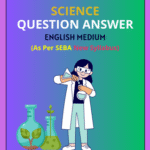SEBA Class 8 Science Chapter 4 Coal and Petroleum Solutions English Medium to each chapter is provided in the list so that you can easily browse through different chapters SEBA Class 8 Science Chapter 4 Coal and Petroleum Question Answer and select need one. SEBA Class 8 Science Chapter 4 Coal and Petroleum Solutions Download PDF. SEBA Class 8 Science Texbook Solutions English Medium.
SEBA Class 8 Science Chapter 4 Coal and Petroleum
Also, you can read the NCERT book online in these sections Solutions by Expert Teachers as per Central Board of Secondary Education (CBSE) Book guidelines. SEBA Class 8 General Science Textual Solutions in English are part of All Subject Solutions. Here we have given Class 8 Science Textbook Question Answer, SEBA Class 8 Science English Medium Textbook Solutions for All Chapters, You can practice these here.
Coal and Petroleum
Chapter: 4
PART – I
EXERCISE
1. What are the advantages of using CNG and LPG as fuels?
Ans: Following are the advantages of using CNG and LPG as fuels:
(i) Cleaner burning: Both CNG (Compressed Natural Gas) and LPG (Liquefied Petroleum Gas) produce fewer pollutants like carbon monoxide, sulfur dioxide, and particulate matter compared to petrol and diesel. This helps reduce air pollution.
(ii) Less greenhouse gas emission: They emit less carbon dioxide per unit of energy produced, contributing less to global warming.
(iii) Cost-effective: They are generally cheaper than petrol and diesel.
(iv) Efficient combustion: Both gases burn more completely, improving engine efficiency.
(v) Reduced engine wear: Because of cleaner combustion, engine parts last longer.
(vi) Safety: CNG is lighter than air and disperses quickly if leaked, reducing fire hazards.
2. Name the petroleum product used for surfacing of roads.
Ans: Bitumen is the petroleum product used for road surfacing. It is a sticky, black, and highly viscous liquid or semi-solid form of petroleum used as a binder in road construction.
3. Describe how coal is formed from dead vegetation. What is this process called?
Ans: Coal is formed from the remains of dead plants and trees that lived millions of years ago in swampy, waterlogged areas. When these plants died, they fell into the swamp water and got buried under layers of mud and water. Because the swampy environment was low in oxygen, the dead plant material could not decompose completely.
Over millions of years, the layers of mud and other sediments above exerted great pressure on the buried plant remains. At the same time, the heat from the Earth’s interior caused chemical and physical changes in the plant material. This combination of pressure and heat gradually transformed the dead plants into a dark, dense substance called peat initially.
With continued pressure and heat over a very long time, peat further changed into coal. During this transformation, called carbonization, water and other volatile substances were squeezed out, and the carbon content of the material increased.
4. Fill in the blanks.
(a) Fossil fuels are ________ _______ and ________.
Ans: Fossil fuels are non-renewable and polluting.
(b) Process of separation of different constituents from petroleum is called _______.
Ans: Process of separation of different constituents from petroleum is called fractional distillation.
(c) Least polluting fuel for vehicle is ________.
Ans: Least polluting fuel for vehicle is CNG (Compressed Natural Gas).
5. Tick True/False against the following statements.
(a) Fossil fuels can be made in the laboratory. (T/F)
Ans: False.
(b) CNG is more polluting fuel than petrol. (T/F)
Ans: False.
(c) Coke is almost pure form of carbon. (T/F)
Ans: True.
(d) Coal tar is a mixture of various substances. (T/F)
Ans: True.
(e) Kerosene is not a fossil fuel. (T/F)
Ans: False.
6. Explain why fossil fuels are exhaustible natural resources.
Ans: Fossil fuels like coal, petroleum, and natural gas are formed over millions of years from the remains of plants and animals buried under the Earth. Because this process takes such a long time, these fuels cannot be quickly replaced once we use them up.
We burn fossil fuels for energy every day for electricity, vehicles, factories, and more. Since we are using them much faster than nature can make new ones, they are called exhaustible natural resources meaning they will eventually run out if we keep using them.
7. Describe characteristics and uses of coke.
Ans: Coke is a special kind of fuel made by heating coal without air. This process removes all the gases and leaves behind a black, hard, and porous solid. Think of it like coal’s “cleaner and hotter” version.
The characteristics of the coke:
(i) It is as hard as stone and is black in colour.
(ii) Coal is one of the fuels used to cook food.
(iii) Earlier, it was used in railway engines to produce steam to run the engine.
(iv) It is also used in thermal power plants to produce electricity.
Usage of Coke :
(i) Coke is mainly used as a reducing agent in the extraction of metals (like iron, zinc, etc).
(ii) Coke is used as a smokeless fuel, in smelting furnaces.
(iii) It is used in the manufacturing of water and producer gas.
8. Explain the process of formation of petroleum.
Ans: (i) Origin of Organic Matter: Millions of years ago, tiny plants and animals called plankton lived in oceans. When they died, their remains sank to the ocean floor.
(ii) Accumulation: These dead organisms mixed with mud, sand, and other sediments at the bottom of the sea. Because the environment was low in oxygen, the organic matter did not fully decompose.
(iii) Burial and Compression: Over time, layers of sediments kept piling up, burying the organic-rich mud deeper under the Earth’s surface. The increasing weight caused pressure and heat to build up.
(iv) Chemical Transformation: Under high pressure and temperature over millions of years, the organic matter slowly transformed into a thick, oily substance called petroleum (crude oil) through a chemical process called diagenesis and catagenesis.
(v) Migration and Accumulation: The petroleum then moved through porous rocks and got trapped beneath impermeable layers of rock, forming oil reservoirs.
(vi) Extraction: These reservoirs are where petroleum is extracted by drilling wells for use as fuel and in various products.
9. The following Table shows the total power shortage in India from 1991-1997. Show the data in the form of a graph. Plot shortage percentage for the years on the Y-axis and the year on the X-axis.
| S.No. | Year | Shortage (%) |
| 1 | 1991 | 7.9 |
| 2 | 1992 | 7.8 |
| 3 | 1993 | 8.3 |
| 4 | 1994 | 7.4 |
| 5 | 1995 | 7.1 |
| 6 | 1996 | 9.2 |
| 7 | 1997 | 11.5 |
Ans:

Hi! my Name is Parimal Roy. I have completed my Bachelor’s degree in Philosophy (B.A.) from Silapathar General College. Currently, I am working as an HR Manager at Dev Library. It is a website that provides study materials for students from Class 3 to 12, including SCERT and NCERT notes. It also offers resources for BA, B.Com, B.Sc, and Computer Science, along with postgraduate notes. Besides study materials, the website has novels, eBooks, health and finance articles, biographies, quotes, and more.




